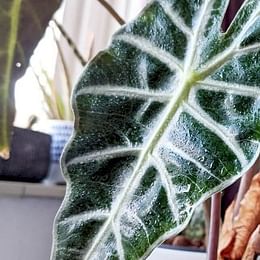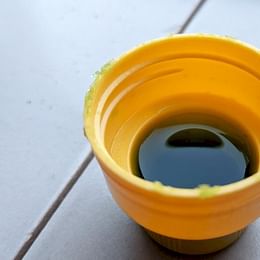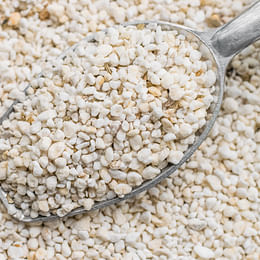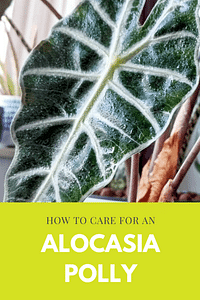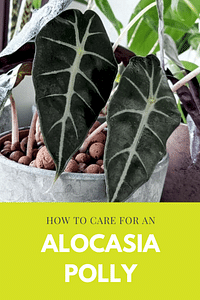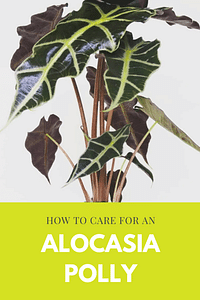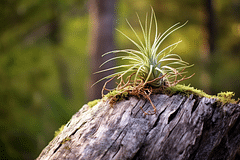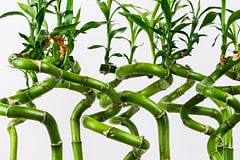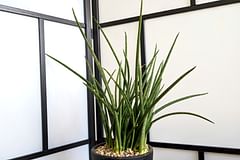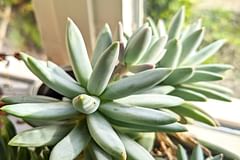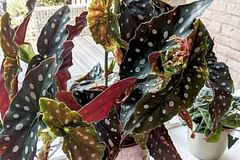How to care for an Alocasia Polly
Discover the secrets to caring for your Alocasia Polly plant! This comprehensive plant care guide will help you grow a thriving Alocasia Polly. Learn simple techniques to keep your houseplant happy and healthy. Begin your journey to becoming a confident plant parent today!
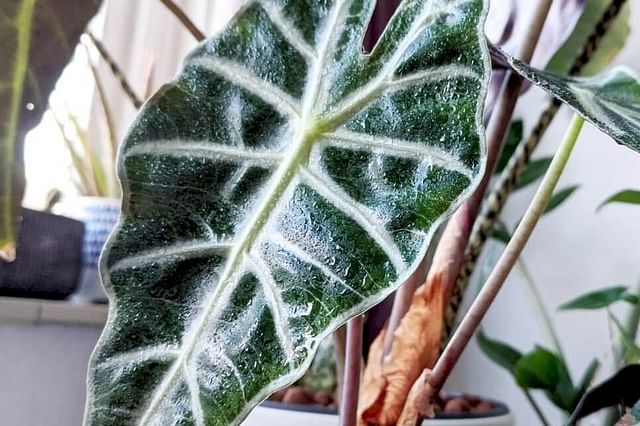
The Alocasia Polly, also known as the Alocasia x Amazonica and African Mask Plant, is a very recognizable plant that you may have seen before on social media or in gardening stores. Its large and odd-shaped leaves with bright nerves will jump out at you from a distance.
Like other Alocasias, the Alocasia Polly is a tropical plant that has very particular needs and might not be the best plant for beginners. However, when you learn to take care of an Alocasia Polly, you'll be able to take care of other, more advanced plants as well.
In this guide, we'll go over all the things that are easy to get wrong when taking care of an Alocasia Polly. While doing so, we'll look at some simple tips and tricks you can use to successfully take care of this plant.
These are the topics we're going to cover in this guide:
If you've already looked at "How to care for an Alocasia Zebrina", you'll see that these two plants are similar in plant care, but there are a few minor differences that this plant has compared to the Alocasia Zebrina.
Let's find out how we can take care of your Alocasia Polly!
Watering your Alocasia Polly
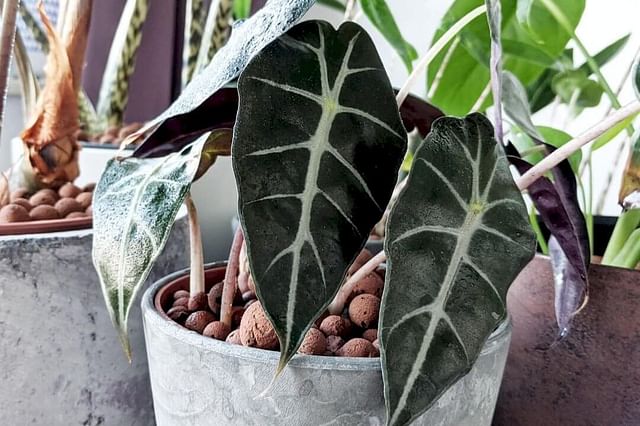
Alocasias are tropical plants, which means they need quite a bit of moisture. However, most Alocasias, including the Alocasia Polly, have thick stems that they use to store moisture. Alocasias use the moisture stored in their stems to feed themselves, so they don't have to rely on moisture in the soil. What this means when it comes to watering your Alocasia Polly is this: You should only water it when the soil is dry.
If you use soil to grow your Alocasia Polly, there is a great trick you can use to determine if your house plant needs to be watered. After you water it for the first time, lift your plant and feel its weight. Now you know how heavy your plant is when you've watered it. After 1-2 weeks, lift your plant again and feel the difference in weight. Your plant should be light at this point. Now you know how light your plant is when it needs to be watered.
You can use this trick throughout the whole year and only water your plant once it's light again. This trick will help you to avoid overwatering your plant in the winter and it'll help you figure out when your plant still has enough moisture to last a few more days.
Sensitive to overwatering
The Alocasia Polly is quite sensitive to overwatering. We've already seen that it stores a lot of moisture in its thick stems and that it likes its soil to dry out. Your Alocasia Polly wants its soil to dry out for 2 reasons:
- You don't want to overwater your Alocasia Polly
- You need to give oxygen a chance to get to its roots
By letting the soil dry out (mostly) before watering your plant again, oxygen can flow freely to your plant's roots and the chances of it getting exposed to root rot are much lower than a plant that grows in soil that's moist all the time.
Light requirements for your Alocasia Polly
Unlike its big sibling the Alocasia Zebrina, the Alocasia Polly doesn't like the sun as much. The Alocasia Polly should be kept in a bright area, but shouldn't get direct sunlight. Adult leaves can tolerate this harsh light for a little while, but this bright sunlight will burn new leaves and dry them out. It's best to avoid this situation altogether and put your Alocasia Polly in a space where it won't get any direct sunlight.
As the Alocasia Polly still wants to be in a bright environment, it will like many other plants, grow towards the light. To make sure your Alocasia Polly grows straight, you should find a bright spot and you could even rotate your plant every few weeks. By doing this, you expose all sides of your Alocasia Polly to a good amount of sunlight exposure and it'll grow straight up.
Brown edges on the leaves
If you notice brown edges on the leaves of your Alocasia Polly, you might have put it in a spot that's getting too much sunlight. If the sunlight is too warm for your Polly leaves, it will burn them and dry them out. When this happens, you'll see the brown edges on the leaves. You should move your Alocasia to a slightly darker place when you notice the brown edges.
Temperature requirements for your Alocasia Polly
Alocasia Polly thrives in warm environments. The ideal temperature range for this plant is between 18 to 29 degrees Celsius (65 to 85 F). It's important to keep the temperature consistent, as sudden changes can stress the plant out.
If you live in a colder climate, you should keep your Alocasia Polly in a warm and bright location, away from any cold drafts or windows. If the temperature drops below 10 degrees Celsius (50 F), it can leave permanent damage to your Alocasia Polly.
If your plant is dealing with temperatures higher than 29 degrees Celsius (85 F), it can put your plant at risk of heat stress. You can look for signs of this by looking at the leaves: yellowing, curling, and wilting will happen. You can prevent this from happening by keeping your plant out of direct sunlight and away from hot drafts.
Humidity requirements for your Alocasia Polly
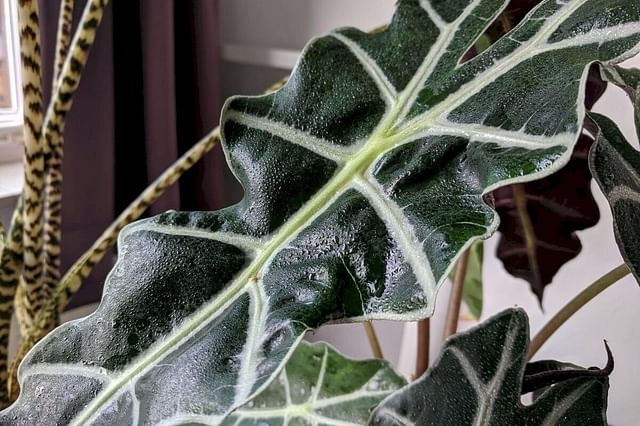
When it comes to Alocasia Polly, high humidity is ideal. In their natural habitat, these plants are used to living in tropical rainforests where humidity is consistently high. So, if you want to give your Alocasia Polly the best possible conditions for growth, you should try to make your plant's growing environment like this as well.
Ideally, this plant needs a humidity level of around 50-60%. It's important to monitor the humidity levels around your Alocasia Polly because if the air is too dry, the plant may develop brown leaf tips or edges, which is a sign of stress. If the humidity is too high, your plant may be at risk of developing fungal or bacterial diseases.
How can you increase the humidity level?
There are a few ways to increase the humidity levels around your Alocasia Polly plant. The first option is to get a humidifier. This is a device that releases moisture into the air, increasing the humidity levels in a room. This can be used all year round, as most modern houses tend to be quite dry.
A cheaper way is to group your Alocasia Polly plant with other plants that like high humidity. When you group plants, they can create a mini jungle microclimate that generates the moisture that each of them likes.
If you don't have a lot of humidity-loving plants, you can also mist your plants more often. You can use a spray bottle to mist the plant with a fine mist to simulate the feeling of humidity. Misting your plant 2-3 times per week is a great starting point.
Finally, placing a tray of water underneath the plant can also help to add humidity to the environment. As water evaporates, it will be absorbed by the plant and the surrounding air.
How can I measure humidity levels?
If you are looking to measure the humidity levels in your home for your house plants, there are a few different methods you can use!
One option for measuring humidity levels is to use a hygrometer, which is a device specifically designed to measure humidity. You can find hygrometers at many garden centers, hardware stores, or online retailers. Simply place the hygrometer near your plants and take a reading to get an accurate measurement of the humidity level.
Another option is to trial and error: simply observe your plants for signs of too much or too little humidity. For example, if you notice that the leaves of your plants are turning brown and crispy, this may be a sign that the humidity levels are too low. On the other hand, if you see that the leaves are becoming yellow or mold is forming on the soil, this may be a sign that the humidity levels are too high.
Soil for your Alocasia Polly

As we've found out in the section about watering your plant, the Alocasia Polly doesn't heavily rely on the soil to provide it with moisture, as it stores a lot of it inside its stems. As a result of this, you need to find a soil that drains water well. Water should not stay in the soil for more than a few days.
If your Alocasia stays in moist soil for more than a week, it could risk suffering from root rot. You should find soil that has plenty of perlite and coconut fibers mixed into it to provide excellent drainage for your soil.
Another solution is to plant your Alocasia Polly in Leca. This helps to water your house plant properly while also allowing plenty of oxygen to reach the Polly's roots. If you want to know more about this, you can have a look at how to do this for the Alocasia Zebrina, as this process is very similar to the Alocasia Polly in "How to grow an Alocasia Zebrina in Leca".
Drainage
Your Alocasia Polly needs well-draining soil to make sure its roots aren't in moist soil for too long. Along with this well-draining soil, you should use a pot that has drainage holes. When you use a pot that has drainage holes, excess water (water that your soil can't absorb), won't stay in the pot. When you use a pot that doesn't have a drainage hole, you risk keeping the excess water at the bottom of the pot. This could lead to root rot. A drainage hole is the easiest solution to avoid this issue.
Fertilizing your Alocasia Polly
Alocasias are quite large plants that grow quite quickly. The Alocasia Polly even blooms throughout the year. These plants use a lot of energy to grow quickly like this. If you want to help your plant keep up this growth, you should make sure to fertilize it once per month in the growing period (spring and summer) and once per quarter, once every three months, in the autumn (fall) and winter.
You can fertilize your Alocasia Polly using liquid fertilizer or fertilizing sticks. When you use fertilizing sticks, make sure to follow the instructions on the package. These sticks usually last about 100 days. When you use these, you won't have to fertilize your plants once per month or once per quarter. In this case, you can stick to 3-4 times per year.
If you want to know more about fertilizing your plants, you can read more in "What is the best type of fertilizer for houseplants?"
Propagating your Alocasia Polly
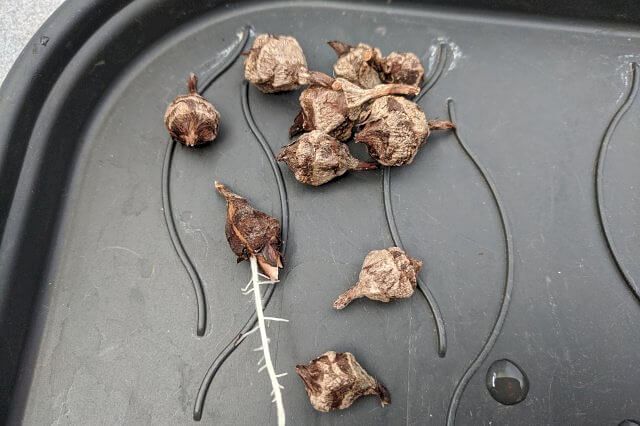
You can propagate an Alocasia Polly in two ways, which are very similar to how it works for an Alocasia Zebrina in "How to propagate an Alocasia Zebrina". You can:
- Harvest Alocasia Polly bulbs
- Separate small plants from the parent plant
Taking the Alocasia Polly bulbs from the parent plant is fairly easy, but depending on your plant, this could be a challenge. To get to these bulbs, you'll need to pull the plant out of the pot and clean the roots. You'll see the bulbs growing on the bottom of the parent plant. This method is quite a lot of work and there is an easier way.
It's easier to wait for these bulbs to start growing plants and separate those baby plants from the parent plant. You'll know where the bulbs of the baby plants are, but you also already have a plant that you can see grow. It can take a while before the bulbs start growing plants on their own and this can discourage you. If you're in this situation, be patient, your bulbs will grow eventually.
Pruning and trimming your Alocasia Polly
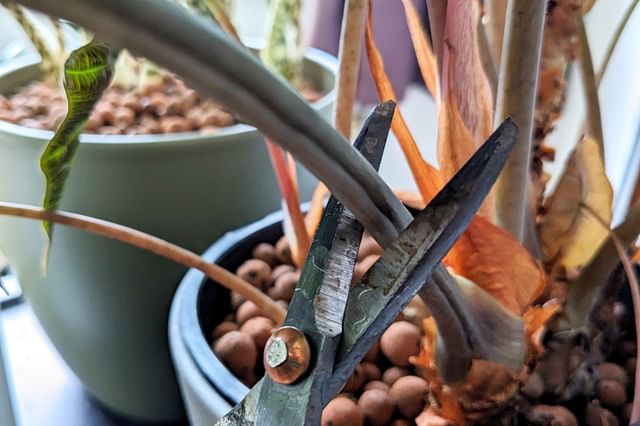
Alocasia Polly is a beautiful plant that requires regular trimming or pruning to maintain its shape and promote healthy growth. Here are some specific tips to help you effectively care for your Alocasia Polly:
Wait for the right time
When you choose to prune your Alocasia, it's best to wait for spring or summer to prune, as your plant will quickly recover and put out new growth. However, if you have dead or dying stems and leaves, you should prune those no matter the time of year.
Use sterile tools
Before you start trimming, make sure to use clean and sterile tools such as pruning shears or scissors. This helps to prevent the spread of disease and guarantees a clean cut. You can easily clean your tools using rubbing alcohol.
Focus on dead or damaged leaves
When trimming your Alocasia Polly, aim to remove dead or damaged leaves first. These can be easily identified by their brown or yellow color and wilted appearance. Removing these leaves will not only improve the plant's appearance but also prevent the spread of disease and pests.
Don't over-trim
While trimming is important, it's also important not to overdo it. Removing too many stems can cause stress to the plant, leading to stunted growth and poor health. Remember, these stems are full of moisture to help the plant grow.
Repotting your Alocasia Polly

Repotting an Alocasia Polly into a larger pot regularly is important to help it grow and thrive. The ideal time to repot an Alocasia Polly is when the roots start to outgrow the current pot and the plant becomes root-bound. This happens, on average, every two years.
The best time to repot an Alocasia Polly is in the early spring when it starts to grow more quickly. This will give the plant enough time to adjust to its new pot and recover from any stress.
Choosing a new pot
Before repotting, it is important to choose the right pot and potting mix.
When you choose a larger pot, you should aim for a pot that is 2.5 to 5 centimeters (1 to 2 inches) larger in diameter than the current pot. This will give your plant enough space for the roots to grow, and prevent the plant from becoming over-potted. This means a plant cannot grow properly because the pot is too large. This pot will hold onto too much moisture and can overwater your plant.
When selecting a pot, it's also important to choose one that has drainage holes to prevent waterlogging and root rot.
What type of potting mix should be used?
When it comes to potting mix, Alocasia Polly thrives in a well-draining mix that allows water to drain away from the roots. A good mixture contains peat moss, perlite, and sand. These components keep the soil loose and light, promoting good airflow and preventing root rot.
Steps to repotting an Alocasia Polly
Here's how you repot your Alocasia Polly:
- Before repotting, make sure the new pot is partially filled with the potting mix.
- Gently remove the Alocasia Polly from its current pot and brush off any loose soil from the roots.
- Carefully separate any circling roots and trim any dead or damaged roots.
- Place the plant in the new pot
- Fill the rest of the pot with potting mix
- Water thoroughly
By watering your plant after repotting, you help the soil settle and give your plant a boost to start growing.
Is the Alocasia Polly toxic for pets or children?
The Alocasia Polly is a beautiful tropical plant, which unfortunately means it's toxic to pets (both cats and dogs) and people. It's toxic when consumed, so make sure to keep this plant out of reach of pets and small children. If your pets happen to consume this plant, make sure to give your veterinarian a call to ask for advice. If your child consumes your Alocasia Polly, immediately call a doctor.
Winter care for an Alocasia Polly
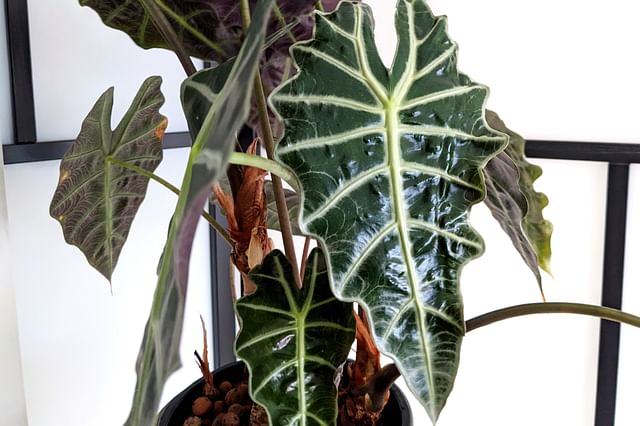
When the winter gets closer and it's getting colder outside, your Alocasia Polly will start its dormancy period. This means different things for different plants, but for the Alocasia Polly, it means that it will slow down its growth and it might even stop growing altogether until the spring.
During this dormancy period, you should water your plant less and stop fertilizing your plant. Your Polly won't need as much energy as it's not growing anymore.
During this dormancy period, your Alocasia Polly might start to drop leaves. It might even drop all of its leaves. This doesn't mean your plant is dying, so you shouldn't throw it away. Your Polly will start to grow leaves again in the early spring and should continue growing like nothing happened. This is just the natural lifecycle of this plant.
Pests and diseases
Alocasia Polly is a fantastic houseplant, but unfortunately, it's not immune to pests and diseases. Here are some of the most common pests and diseases that can affect your Alocasia and how to prevent or treat them if they happen:
Spider mites
These tiny, spider-like pests can suck the life out of your plant, causing it to wither and die. To prevent spider mites, always keep your plant's environment humid. If they have already infested your plant, you can spray it with neem oil or insecticidal soap to get rid of them.
To identify spider mites, you can check the Alocasia Polly's leaves, stems, or soil. Spider mites feed on chlorophyll in the plant's leaves, which can lead to yellow spots appearing on the surface of the leaf. These yellow spots can look like stippled marks or tiny dots.
These pests also hide on the undersides of the leaves or in the spaces where the leaves meet the stem. Carefully inspect these areas to see if you can spot any tiny, web-like structures or small black or red specks. You can also determine if your Alocasia Polly is a victim of spider mites by the fine webbing they leave around the leaves, stems, or soil surrounding the plant.
Mealybugs
These white, cotton-like pests can be a real headache for Alocasia Polly owners. To prevent mealybugs, make sure to inspect your plant regularly and quarantine it if you see anything. Treating mealybugs involves using a cotton swab dipped in rubbing alcohol to remove them from your plant.
Mealybugs are typically found in clusters or groups, and they may appear as small, white specks on the surfaces of the leaves. You may also notice small, sticky droplets of honeydew that the bugs excrete as they feed on the plant. You may also notice that the leaves of your plant become yellow, wilted, or distorted, which are all symptoms of mealy bug damage.
Bacterial blight
This disease is caused by the Xanthomonas campestris bacteria, which can result in yellowing leaves as well as black, mushy stems. To prevent bacterial blight, make sure that your plant gets enough drainage and avoid overwatering it. If you suspect your plant has this disease, remove the infected parts and spray your plant with a copper fungicide.
Root rot
Overwatering your Alocasia Polly can lead to root rot, which causes the roots to turn brown and mushy or slimy. To prevent root rot, make sure that your plant pots have sufficient drainage holes. If you suspect root rot, remove the affected roots and repot your plant into fresh soil. Now wait a day or so before watering your plant.
Troubleshooting common issues
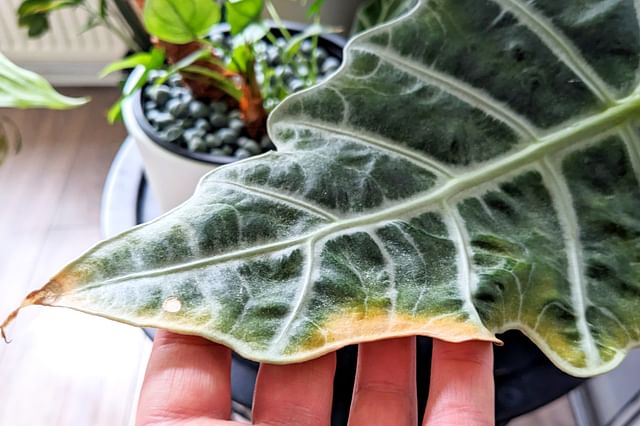
We've now looked at all things related to taking care of an Alocasia Polly. You should now have all the information you need to keep your plant healthy. However, accidents happen and plants can be difficult. So let's look at a few of the common issues you Alocasia might deal with and how to fix it.
Wilting
If you notice that your Alocasia Polly's leaves are wilting, it may be a sign that the plant is not getting enough or too much water. Always check the soil before watering, only water when the soil is mostly dry, and make sure that the soil is well-drained.
Don't water this plant more than once per week and you likely won't have to deal with any issues.
Stunted growth
If your Alocasia Polly is not growing as fast as you would like, it may be a sign that the plant is not getting enough nutrients. To fix this, you can fertilize the plant with a slow-release fertilizer or a water-soluble fertilizer.
Stunted growth can also be a result of the plant's pot being too small. Make sure that your plant has enough space, and if not repot it into a larger pot.
Yellow or dropping leaves
An Alocasia Polly can only sustain a certain amount of leaves before getting rid of old leaves. When your plant is getting rid of old leaves, they will start to turn yellow before they die. When you see your leaves turn yellow it simply means that your plant is killing them off to preserve energy to stay alive or to grow new leaves. This is its natural growth cycle and nothing to worry about.
However, you could also be dealing with pests such as spider mites or thrips. Look for tiny webs or tiny insects on the plant's leaves. You can remove these pests by cleaning the plant's leaves with a solution made of water and mild detergent.
Another possible reason for yellowing and dropping leaves is exposure to too much direct sunlight. Consider moving your plant to a more shaded area, or use a sheer curtain to filter the light.
Conclusion
The Alocasia Polly is very similar in care to other Alocasias, but it does have a few different tricks to help it thrive. Your houseplant absorbs a lot of moisture and stores it in its stems, so you shouldn't water too much. This plant doesn't rely too much on the soil to provide it with moisture. As it's a fast-growing plant, provide it with fertilizer once per month in the growing period (spring and summer) and slow down in the dormancy period (autumn/fall and winter). Your Alocasia Polly loves a bright spot but doesn't like direct sunlight.
Thank you for reading this post! I hope it helps you to keep your plants healthy and beautiful! If you're looking for more guides on specific plants, you can always request a plant guide to get a guide for the plant you have trouble with.
Test your plant care knowledge
Quiz completed!
Want to learn more? Sign up for my newsletter to receive free tips in your inbox!
Sign up now!